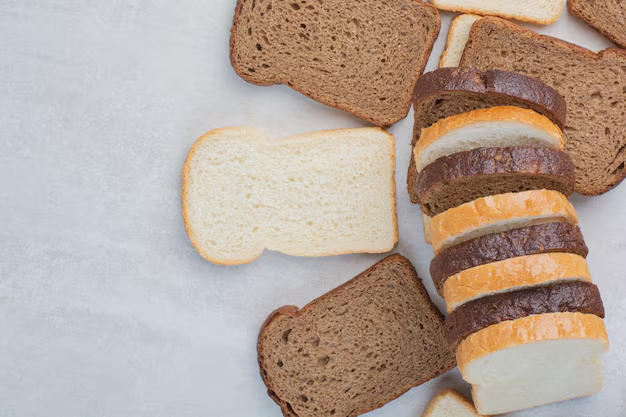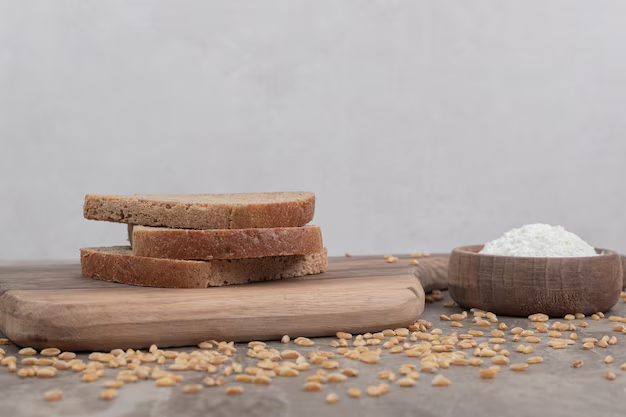Bread is a staple food in many diets, but it often raises concerns for those managing diabetes. Many people wonder, “Is bread bad for diabetes?” The answer isn’t simple. Bread can impact blood sugar levels, but the type of bread you choose plays a critical role. Understanding how bread affects your body and selecting healthier options can make it a manageable part of a diabetic diet.
Is Bread Bad for Diabetes?
Bread, a staple in many diets, can be a concern for people with diabetes due to its carbohydrate content and potential impact on blood sugar levels. However, whether bread is “bad” for diabetes depends on several factors, including the type of bread, portion sizes, and individual blood sugar response.
When you consume bread, your body breaks it down into glucose (sugar), which enters your bloodstream. High-carb breads, especially those made from refined white flour, can cause a rapid spike in blood sugar. This is particularly important for people with diabetes, who need to monitor their blood sugar levels carefully.
Does Bread Spike Blood Sugar Level For Diabetics?
Bread contains carbohydrates, which are broken down into glucose, raising blood sugar levels. For people with diabetes, this spike can be significant, depending on the type of bread and portion size.
Highly processed breads, like white bread, are made from refined flour, which causes rapid blood sugar spikes. On the other hand, whole-grain or high-fiber breads have a slower effect on glucose levels because the fiber slows digestion and absorption.
Choosing bread with a low glycemic index (GI) is essential to avoid large blood sugar fluctuations. GI measures how quickly a food raises blood sugar. Lower-GI bread options are better for diabetes management.
Types of Bread for Diabetics

Not all bread is created equal. Some types are better suited for a diabetic diet due to their nutritional profile.
1. Is Whole Wheat Bread Good for Diabetes?
Whole wheat bread is a better option than white bread for diabetics. It is made from whole grains, which retain the bran and germ, offering more fiber and nutrients. This fiber content slows down digestion, reducing blood sugar spikes.
However, it’s important to check labels. Some “whole wheat” breads contain added sugars, which can counteract the benefits.
2. Is Sourdough Bread Good for Diabetics?
Sourdough bread can be a good choice for diabetics. The fermentation process used to make sourdough reduces its glycemic index. This means it raises blood sugar levels more slowly than other types of bread. Additionally, sourdough contains probiotics, which may benefit gut health.
3. Is Rye Bread Good for Diabetes?
Rye bread, particularly whole-grain rye, is another excellent choice for diabetics. Rye has a dense texture and is high in fiber, which helps control blood sugar. Research suggests rye bread has a lower glycemic index than wheat bread, making it a diabetes-friendly option.
4. Is Multigrain Bread Good for Diabetics?
Multigrain bread can be good for diabetics, but it depends on the grains and ingredients used. Look for multigrain breads that list whole grains as the first ingredient and avoid those with added sugars or refined flours. High-fiber multigrain bread is a good choice for stabilizing blood sugar levels.
Best Bread for Diabetics
The best bread for diabetics is one that is:
- Made from whole grains.
- High in fiber (at least 3 grams per slice).
- Low in added sugars.
- Low on the glycemic index.
Examples include 100% whole wheat bread, whole-grain rye bread, and sprouted grain bread.
Alternatives and Recommendations
If you’re looking for better options, here are some alternatives and tips to make bread work in a diabetic diet.
Low-Carb Bread for Diabetics
Low-carb bread is specially designed for people watching their carbohydrate intake. These breads use ingredients like almond flour, coconut flour, or flaxseeds instead of traditional grains. They have minimal impact on blood sugar levels.
Bread Alternatives for Diabetes
If you’re looking to reduce or avoid bread, consider these alternatives:
- Lettuce Wraps: Use large lettuce leaves to replace bread in sandwiches.
- Cauliflower Bread: Made from cauliflower and eggs, this is a low-carb, gluten-free alternative.
- Portobello Mushrooms: Use as buns for burgers or sandwiches.
- Sweet Potato Slices: Roast slices of sweet potato to use as a base for toppings.
How to Choose Bread for Diabetes?
When selecting bread, read labels carefully. Here’s what to look for:
- Whole Grains: Ensure whole grains are the primary ingredient.
- Fiber Content: Aim for at least 3–5 grams of fiber per serving.
- Added Sugars: Avoid breads with added sugars or sweeteners.
- Low Glycemic Index: Choose breads with a GI of 55 or lower.
Diabetic-Friendly Bread Brands
Several brands cater to diabetics by offering low-GI and high-fiber options. Here are a few popular ones:
- Ezekiel 4:9 Sprouted Grain Bread: Made from sprouted grains, rich in nutrients and fiber.
- Dave’s Killer Bread (21 Whole Grains and Seeds): Packed with fiber and whole grains.
- Nature’s Own Sugar-Free Bread: A low-sugar option ideal for diabetics.
- Alvarado Street Bakery Sprouted Wheat Bread: A wholesome choice with a low glycemic index.
To Read: Pumpkin Recipes For Diabetics
Nutritional Considerations

Here are some bread nutrient considerations that diabetics should keep in mind before consuming bread.
Carbs in Bread for Diabetics
Carbohydrates in bread are a primary concern for diabetics. Most bread contains 12–20 grams of carbs per slice. For comparison:
- White bread: Around 15 grams of carbs per slice.
- Whole-grain bread: Slightly higher at 17 grams but with added fiber to slow sugar absorption.
- Low-carb bread: Often 5–10 grams per slice, making it a better choice for diabetics.
Carbs raise blood sugar, so controlling intake is essential for maintaining stable glucose levels.
Glycemic Index of Bread for Diabetes
The glycemic index (GI) measures how quickly a food raises blood sugar:
- High-GI breads: White bread and refined options with a GI of 70 or more cause rapid spikes.
- Medium-GI breads: Whole wheat and rye bread have a GI between 55 and 69.
- Low-GI breads: Sprouted grain and sourdough breads, with a GI under 55, are slower to digest and better for blood sugar control.
Knowing a bread’s GI can help diabetics make informed dietary choices.
How Much Bread Can a Diabetic Eat?
Portion size matters. Most diabetics can safely consume 1–2 slices of bread per meal, depending on their daily carb allowance. Pairing bread with protein, healthy fats, or fiber-rich foods can further stabilize blood sugar levels.
Is Bread Bad for Type 2 Diabetes?
For type 2 diabetics, bread isn’t inherently bad but must be chosen wisely. Refined breads with added sugars can worsen insulin resistance, while whole-grain options may support better glucose management.
Does Bread Cause Insulin Resistance?
Regular consumption of refined carbs, like white bread, can contribute to insulin resistance over time. Insulin resistance makes it harder for the body to use insulin effectively, leading to elevated blood sugar levels. Whole-grain and low-carb breads are better for avoiding this risk.
Effects of Bread on Blood Sugar
The type of bread, serving size, and what it’s paired with affect blood sugar responses. Bread made from refined flour causes rapid spikes, while fiber-rich and low-GI breads have a gentler effect on glucose levels.
Is Toast Bad for Diabetes?
Toast isn’t inherently worse than regular bread. However, the toppings you choose matter. Avoid butter or sugary spreads. Instead, opt for avocado, almond butter, or sugar-free jam to keep it diabetes-friendly.
Is Ezekiel Bread Good for Diabetics?
Ezekiel bread, made from sprouted whole grains, is an excellent choice for diabetics. It’s high in fiber and protein, with a low glycemic index. Its nutrient density and slow-digesting carbs make it a heart-healthy and diabetes-friendly option.
Managing Diabetes with Low-Carb Bread
Low-carb breads are designed to minimize blood sugar impact. They often use almond or coconut flour, flaxseeds, or psyllium husk. These alternatives are lower in carbs and higher in fiber, helping diabetics maintain better glucose control.
FAQs
Is bread bad for gestational diabetes?
Moderation is key. Whole-grain, low-GI bread is better for managing gestational diabetes. Always monitor blood sugar levels after consumption.
How does bread affect A1C levels?
Frequent consumption of high-carb or high-GI bread can raise blood sugar and A1C levels. Opt for low-GI options like whole-grain or sourdough bread.
Is gluten-free bread good for diabetics?
Gluten-free bread isn’t automatically better for diabetes. Choose options with low carbs and a low glycemic index, and monitor your blood sugar.
Conclusion
Is bread bad for diabetes? The answer depends on the type, portion size, and how it fits into an overall diet. While refined white bread can spike blood sugar and worsen insulin resistance, whole-grain, low-carb, or sprouted grain breads can be part of a balanced diabetic meal plan. Choosing low-GI options, practicing portion control, and pairing bread with nutrient-dense foods are essential strategies. Consult a healthcare provider for personalized advice on incorporating bread into your diabetic diet.

